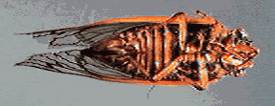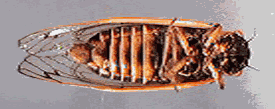Magicicada
Some time in May or June of this year (2004) the periodical cicada population known as 17-year Brood X will begin to emerge. It is the largest of the 17 broods that have been tracked since 1952.
This year’s brood began in 1982 as eggs laid in Y shaped nests in the twigs of trees. In 6-12 weeks the eggs hatch and the first-instar nymphs drop to the ground. They spend the next 17 years (or 13 or fewer depending on the species) feeding on root fluids. The nymphs go through 5 juvenile stages, growing from the size of a small ant to nearly their adult size (25-50mm). As they reach the final stage the nymphs construct exit tunnel s, 1/2 inch in diameter holes sometimes with a mud chimney like structure providing a “doorway”.
When the temperature in the tunnels reaches 64 degrees F. the nymphs begin to emerge. Most of the brood will emerge in one evening. The final stage nymphs head for the nearest vertical surface, usually a tree, and begin to molt. It takes about an hour for the cicada to shed its final skin. Within 12 hours the exoskeleton begins to anneal and at the end of 4-6 days it is completely hard. The cycle then begins over again.
Unless, of course, some alert gourmet interrupts the cycle. The time to get out there is just as the final molt takes place, usually in the early morning. The cicadas at this stage called tenerals are the inland equivalent of a soft-shelled crab, creamy white and eminently edible. They can be scooped from the trunks of the trees before they climb out of reach.
You may proceed to cook your bounty at this point but if cicadas and eggs for breakfast seems a bit much you can refrigerate them for later. Refrigeration will slow the maturation process. The cicadas may also be frozen but freezing will change the texture so that they may not be suitable for dishes that call for fresh cicadas.
The simplest way to cook them is to dry roast them as the Native Americans did. Preheat the oven to 350 degrees, spread the cicadas on a cookie sheet and roast about 5 minutes. (Or you can use hot rocks if you want to be authentic.)
Once they are roasted serve with toothpicks a collection of dipping sauces. Try honey mustard, soy sauce, melted cheese, or ketchup. You might try dipping them in honey or chocolate covering them for a sweet treat.
You can grind your surplus roasted cicada to use as nut substitute. A finer grind can be mixed 50:50 with flour to make high-protein dough for bread or biscuits.
Purists tend to like their cicadas boiled for just a few minutes. Drop cicadas briefly in boiling water and coat with red pepper, garlic and ground bay leaf.
In stir fried dishes cicadas are reported to be the equivalent of bean curd. They absorb the flavors of the vegetables or seasonings that are added to the dish. Try them stir-fried with garlic, ginger and bite-sized vegetables.
Experienced cicada-eaters suggest that these high protein treats have more “crunch than flavor”. The following recipe increases the crunch and certainly boosts the flavor.
Deep Fried Cicadas
5 cicadas, wings and legs removed if shells are hard.
1/4 cup Worcestershire sauce
1 egg, lightly beaten
1/4 cup flour
1/2 cup seasoned dry breadcrumbs
1/4 cup seafood cocktail sauce
1. Marinate cicadas in Worcestershire sauce at least 1 hour.
2. Dip into flour, egg and then into breadcrumbs.
3. Deep fry and serve with cocktail sauce.
If you haven’t been lucky enough to get your cicadas in the teneral or soft-shelled stage, be sure to remove the wings and legs before cooking. Pick only the females as the males have a hollow abdomen and are reportedly the equivalent of air popped popcorn. The females are full of eggs and fat and provide a more nutritional snack.
Bon appetite!

